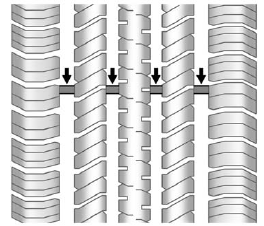When It Is Time for New Tires
Factors such as maintenance, temperatures, driving speeds, vehicle loading, and road conditions affect the wear rate of the tires.

Treadwear indicators are one way to tell when it is time for new tires.
Treadwear indicators appear when the tires have only 1.6mm (1/16 in) or less of tread remaining. See Tire Inspection and Tire Rotation for more information.
The rubber in tires ages over time.
This also applies for the spare tire, if the vehicle has one, even if it is never used. Multiple conditions including temperatures, loading conditions, and inflation pressure maintenance affect how fast aging takes place. Tires will typically need to be replaced due to wear before they may need to be replaced due to age. Consult the tire manufacturer for more information on when tires should be replaced.
Vehicle Storage
Tires age when stored normally mounted on a parked vehicle.
Park a vehicle that will be stored for at least a month in a cool, dry, clean area away from direct sunlight to slow aging. This area should be free of grease, gasoline, or other substances that can deteriorate rubber.
Parking for an extended period can cause flat spots on the tires that may result in vibrations while driving. When storing a vehicle for at least a month, remove the tires or raise the vehicle to reduce the weight from the tires.
See also:
How to Check Lubricant
To get an accurate reading, the vehicle should be on a level surface.
For Two-Wheel-Drive vehicles, the proper level is from 15mm to 40mm (0.6
in to 1.6 in) below the bottom of the filler plu ...
The Inside
If I had to drive forever in the Escalade's optional heated and cooled seats,
I don't think I could complain. Why every luxury car doesn't come with
ventilation is a mystery. On a hot hour-long ri ...
Front Turn Signal Lamp (Base and Uplevel)
To replace the Front Turn Signal Lamp:
1. Remove the turn signal lamp bulb socket from the headlamp assembly.
2. Remove the turn signal lamp bulb from the socket.
3. Replace the bulb in the bulb ...






